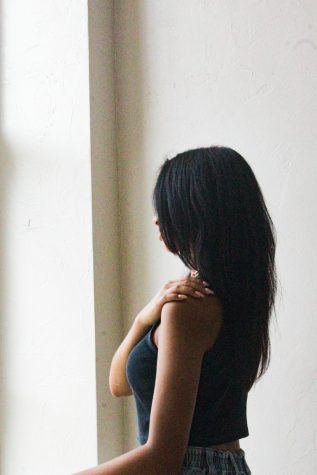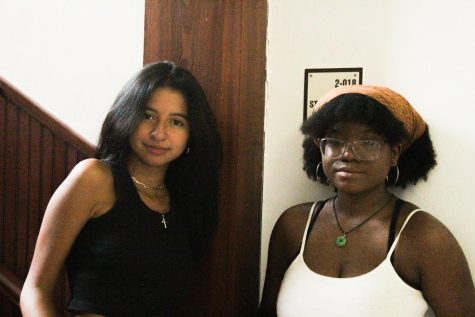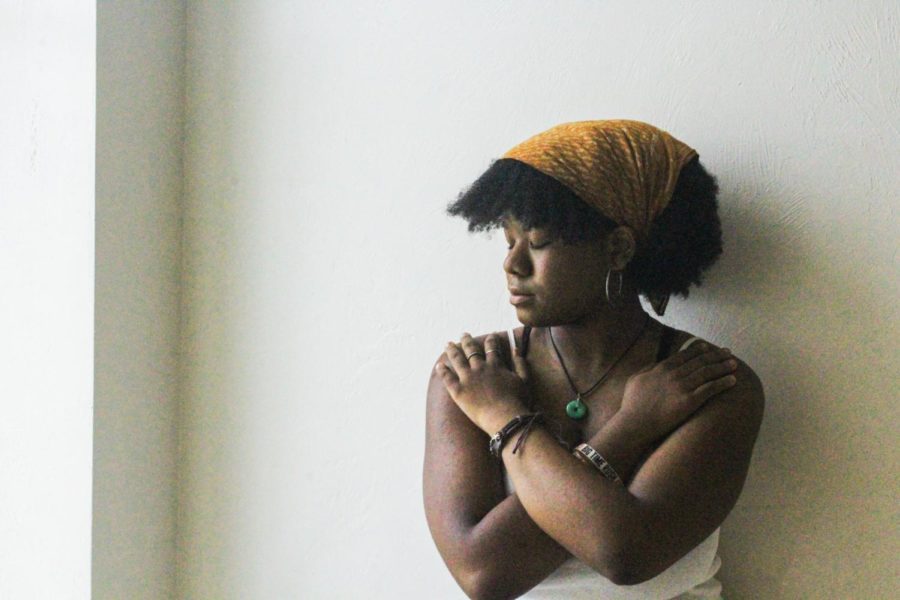Members of administration were contacted but declined to comment.
Theatre senior Théa Lamy struts the halls, chin up high in her red tank top, paired with light washed jean shorts. Moments later, this freedom is taken away from her as her top is labeled ‘inappropriate’ by a passing staff member. As Lamy’s friend points out to the employee, other girls are wearing similar tops, but they aren’t called out for it.
“Because my chest is bigger, it looks different on me than (it looks on another girl),” Lamy said. “Because I come from a very Christian household, my mom has always told me to cover up, (to not) show those parts of myself.”
Dress code is a long-standing controversy. As an arts school, some use fashion as a medium for artistic and self expression, finding a rigid dress code restrictive of their creative freedom. Others consider the school’s dress code too relaxed in what students are allowed to wear. The enforcement of dress code is up for debate among students, teachers, and parents: is the very idea sexist and fatphobic, or is it applied as necessary to each individual body?
The trademark line that those in favor of a strict dress-code typically quote is that it can be distracting for both students and teachers in a classroom environment. Vocal senior Jacqueline Alvarado shared “my body isn’t something you should be distracted by.”
“Personally, I do show a lot of skin at school,” Alvarado said. “It’s a little weird on my end, with a male teacher. Why are you telling me to cover up? I’m a child, please don’t stare at my midriff … it shouldn’t be distracting you from your teaching.”
While some teachers find students’ outfits divert their attention away from the lesson, others, such as theatre teacher Charles Swan, find that unsettling.
“I am way too busy during the course of the school day to be distracted by a student’s midriff,” Mr. Swan said. “I think (other teachers) should consider ways they can structure their 100 minutes to be super busy, gregarious, joyous and full, so they (don’t have the time to) be distracted by their students’ (bodies).”
Mr. Swan adds the restrictions outlined in the district dress code bring up problems of their own. The district dress code includes “clothing that is sexually suggestive or revealing.”
“I think it’s interesting that we immediately are lumping muscles…girls’ shoulders…under the umbrella of sexually suggestive,” Mr. Swan said. “I don’t think arms scream sex. I don’t think midriffs scream sex.”
Students, such as dance sophomore Yariel Williams, have pointed out, in some cases, it can get to the point where an outfit becomes a distraction. Williams is grateful for our lenient dress code but also acknowledges students aren’t the issue.
“(Somebody’s outfit) could be distracting to other students, depending on how revealing their clothing may be,” Williams said. “But for the most part, I feel like it’s more (at the) level of the adults.”
No matter who it may be distracting, a common theme keeps appearing: the lenient dress code doesn’t seem to bother the students. It’s not only teachers, either. Parents can also play a role in how their teens express themselves at school, as Lamy says.
“My mom is very strict with dress code,” Lamy said. “She actually hates how lenient Dreyfoos is with dress code. She wishes it was more strict. If she had seen the way kids dress before she took me to the school, she probably wouldn’t have taken me here. She’d have wanted (me to go to) a school with a uniform.”
While some parents and teachers may feel a stricter dress code would be beneficial, students such as visual sophomore Bee Fielding feel that education and clothing are separate ideas.
“How we dress isn’t changing our educational experience or how much we’re learning,” Fielding said. “I think some of the rules definitely need to be revised to account for that.”
Dance freshman Sydney Broadfield discussed that in her first few weeks on campus, she has appreciated seeing the creative freedom of dress the school offers.
“We’re not all locked up,” Broadfield said. “We don’t have a uniform. We’re allowed to express ourselves however we want, which I think is great. There are rules, but they’re rules that make sense.”

Lamy shares a similar viewpoint, expanding on the idea of being able to foster an artistic community through fashion.
“If Dreyfoos were to get a uniform, it would not be Dreyfoos,” Lamy said. “There’s so much expression through the outfits we wear. So many people make their own outfits, thrift and upcycle their outfits, or paint on their jeans and shoes.”
Lamy believes this is part of what makes the school such an uplifting environment, and appreciates that “we have this ability to express ourselves and show off who we really are.”
“Kids express themselves in such a way (that) it differentiates you from the person standing next to you,” Lamy said. “I feel like a uniform, or even a stricter dress code, wouldn’t make us more united, as a uniform should do. It would make us worse. It would make us feel like we have to be put into a box with everybody else (and) conform to (others’) expectations.”
Cases of dress coding on campus are limited. However, out of those students who are dress coded, some, such as Fielding, have noticed a bias which targets those who identify as female.
“The dress code is definitely geared to be more discriminatory towards women specifically,” Fielding said. “Historically, women have always been told what to wear and when to wear it. It’s not even just educational environments where there are dress codes, but dress codes within life.”
Fielding elaborates on the idea that women can’t win – “they tend to be under constant fire no matter what they do.”
“Women can never expose too much skin, or they’re expected to show more skin,” Fielding said. “It’s always been an issue of ‘you women have to wear this or that,’ but there’s never been a very tight dress code for men, and it’s definitely due to the societal hierarchy of gender.”
Aside from the gender-specific biases, the potentially unequal enforcement of dress code based on body type is a sentiment Alvarado expressed. Alvarado feels that her clothing tends to be viewed as provocative because of her body type, even when she’s wearing the same types of clothing as other people around her.

“It doesn’t fit (me) the way it would fit on a Brandy Melville standard girl,” Alvarado said, referring to the popular clothing brand known for its catering to petite girls. “Their ‘it’ girl, (clothes) wouldn’t fit on me like that. The school dress code combined with today’s fashion is not built for people who look like me.”
Lamy shares a similar idea, concluding that while the school’s current dress code may give us a longer leash that some may take advantage of, it doesn’t make sense to tighten restrictions on others, eliminating the opportunity to “express how creative and artistic we are.”
“People should still be allowed to be confident in what they’re wearing, and not be brought down just because of something they can’t control,” Lamy said. “For me, a lot of my friends are very petite, and we share clothes all the time. However, some of these clothes look more inappropriate on me than on them. But that’s just the way my body is, and it’s not something I can change. I’m not going to cover up just because I look different.”
This story was originally published on The Muse on September 11, 2022.
































![IN THE SPOTLIGHT: Junior Zalie Mann performs “I Love to Cry at Weddings,” an ensemble piece from the fall musical Sweet Charity, to prospective students during the Fine Arts Showcase on Wednesday, Nov. 8. The showcase is a compilation of performances and demonstrations from each fine arts strand offered at McCallum. This show is put on so that prospective students can see if they are interested in joining an academy or major.
Sweet Charity originally ran the weekends of Sept. 28 and Oct. 8, but made a comeback for the Fine Arts Showcase.
“[Being at the front in the spotlight] is my favorite part of the whole dance, so I was super happy to be on stage performing and smiling at the audience,” Mann said.
Mann performed in both the musical theatre performance and dance excerpt “Ethereal,” a contemporary piece choreographed by the new dance director Terrance Carson, in the showcase. With also being a dance ambassador, Mann got to talk about what MAC dance is, her experience and answer any questions the aspiring arts majors and their parents may have.
Caption by Maya Tackett.](https://bestofsno.com/wp-content/uploads/2024/02/53321803427_47cd17fe70_o-1-1200x800.jpg)
![SPREADING THE JOY: Sophomore Chim Becker poses with sophomores Cozbi Sims and Lou Davidson while manning a table at the Hispanic Heritage treat day during lunch of Sept 28. Becker is a part of the students of color alliance, who put together the activity to raise money for their club.
“It [the stand] was really fun because McCallum has a lot of latino kids,” Becker said. “And I think it was nice that I could share the stuff that I usually just have at home with people who have never tried it before.”
Becker recognizes the importance of celebrating Hispanic heritage at Mac.
“I think its important to celebrate,” Becker said. “Because our culture is awesome and super cool, and everybody should be able to learn about other cultures of the world.”
Caption by JoJo Barnard.](https://bestofsno.com/wp-content/uploads/2024/01/53221601352_4127a81c41_o-1200x675.jpg)






